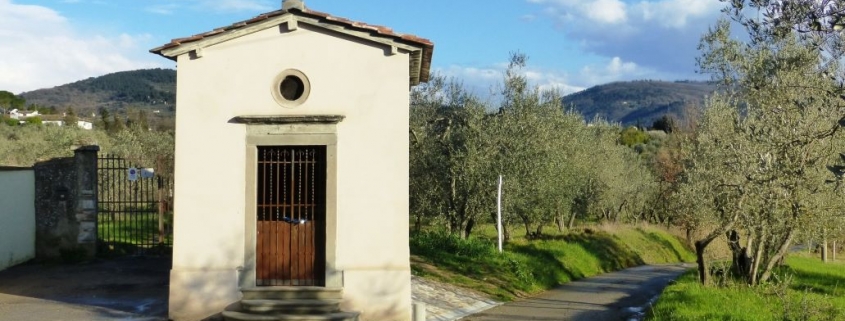Itinerary by car, motorcycle or bicycle 2 – The Sacred Streets
Sacred Streets: the Bagno a Ripoli, Villamagna and Antella Parishes
Type of route: paved, practical for cars, motorcycles and bikes
Duration: 1 day
Difficulty: easy
Our trip begins at the Pieve di S. Pietro a Ripoli, located on an ancient pilgrimage route that led to Rome, Assisi and the Loreto sanctuary. Over the course of the Middle Ages the path became particularly important for exchanges between Florence and Arezzo. The numerous structures dedicated to hospitality and assistance that dotted the road, particularly concentrated in key spots, are testimony to the intensity of transit along it. The concentration of inns, hospitals and taverns documented in the 14th century along the road would have had no equal in all of Tuscany.
Along this ancient route we will first encounter the Santa Maria in Quarto Church. The Church owes its name to the fact that it is located at the fourth mile of the Via Aretina. Although little remains of the original 13th century building, apart from the exterior limestone walls with the medieval entrance and frescoed lunette on the left-hand side (late 14th century), it is still worth a quick visit.
Leaving the Santa Maria in Quarto Church behind and heading towards Pontassieve, we reach Candeli and the majestic Church of Sant’Andrea in Candeli, an ancient Benedictine abbey and home to an important crucifix.
From Candeli we now take the Via Villamagna until reaching the city of the same name and the Pieve di San Donnino. The Church provides an excellent example of medieval architecture. Although it was restored and expanded in the Romanesque period, many of the Church’s original features were left intact.
Our journey continues on by following the directions for the Convento dell’Incontro. Along the way we can admire the Oratorio del Beato Gherardo, the place in which it is said that the Saint retired in the 13th century to lead a monastic life.
Leaving the Oratory behind us, we continue along the winding road as it travels uphill towards the Convento di San Francesco all’Incontro. Here we recommend that you leave the car behind and take a pleasurable ramble to the Convent and surrounding areas on foot.
Leaving the hills of the Convent and heading back towards the city, we recommend that you take the Ritortoli municipal road. After a few curves, take a left once having finished the uphill portion of the road. It is here that you will be able to admire the quaint San Tommaso a Baroncelli Church, sitting on top of a hill by the same name and completely immersed in nature. Some assert that this Church was built on top of the ruins of a Lombard fort, although no remaining evidence can actually support this claim. The Church houses an important Annunciation fresco that has been attributed to the School of Fra Angelico. One can also find a 16th century banner bearing an embroidered crucifix, the gift of Cosimo I de’ Medici to the Ripoli population in the 18th century. The relic was venerated until recent times as it had been considered miraculous.
Not far from the Baroncelli hills, along the panoramic Via del Carota in Ponte a Ema, we find the Santa Caterina delle Ruote a Rimezzano Oratory, gem of Bagno a Ripoli.
Heading along Via del Carota, we take the old Via Romea, the historic path used by pilgrims to reach one of the most important places of rest and healing in Tuscany, the Antico Spedale del Bigallo.
Founded in the first half of the 13th century and entrusted to the Compagnia Maggiore della Vergine Maria in 1245 (only later was “del Bigallo” part of the name), the structure served as a hotel for pilgrims and place of assistance for travelers. The building is now used as a hostel and space for various types of events. It is recommended that the surrounding area on the Apparita hill be explored on foot, as it is characterized by a series of natural pathways and breathtaking views of Florence and Valdarno. It has been said that during the siege of Florence that the Prince of Orange, once having arrived atop the Apparita hill, exclaimed: “…If my land had been so beautiful I would defend it too…!”
Retracing our steps back to Via del Bigallo e Apparita, turning onto the historical Via Terzano, we will pass under the vault of the Arco del Camicia (after which you will be able to admire a 13th century tower house) before arriving at the Santo Stefano a Paterno Church. The Church was built in modern times in the Romanesque revival style and is the heir to the previous church that no longer exists. A beautiful crucifix with Christus Patiens, notable for the intense drama of the painted form by Gaddo Gaddi (a follower of Cimabue) can be found within. The Compagnia del Bigallo was probably responsible for bringing the painting to the Church, deducible thanks to the curious anagram formed by the letter “B” surmounted by a gallo (rooster) painted in the suppedaneum.
The Church is also home to a fresco depicting the Virgin and angel attributable to the 15th century Florentine school. Its jeweled adornments attest to its devotional importance. A depiction of Mary and Joseph adoring the Christ Child, a copy of a Fra Bartolomeo attributed to Fra Paolino da Pistoia, can also be admired.
Not far from here, on the Via della Croce, a partially paved road with an incredible view of Florence, we reach the San Lorenzo a Vicchio di Rimaggio Church after a short detour. The Church, documented in as early as the 12th century, is home to several late-14th century frescoes attributed to the Florentine painter Cenni di Francesco.
Back on Via Roma (SP 1), heading towards the village of Osteria Nuova, it is possible to reach Ruballa. It is here that two important examples of medieval country churches can be found: San Quirico e Giulitta a Ruballa and San Giorgio a Ruballa. Adjacent to the Church rests the Museo di Arte Sacra.
Taking Via Peruzzi you will arrive at Antella. The historic city center has ancient origins. Among the many hypotheses, the most probable is that the name can be traced back to the Etruscan name Antilius (Antonio), the male version of Antulla. The undisputed antiquity of the location has been confirmed both by Etruscan finds (including an architectural sandstone fragment) and by the artifacts unearthed at the Roman villa of Publio Alfio Erasto. The Romanesque Santa Maria Pieve, an excellent example of medieval architecture, stands in the main piazza of Antella.
The Cimitero Monumentale dell’Antella can be reached by taking the Via di Montisoni from Piazza Peruzzi. It was built between 1855 and 1856, while the imposing entrance arch dates back to 1912. The drum of the dome is decorated by a beautiful fresco by Galileo Chini. The cemetery has gradually expanded past the borders of the original design, and now provides sanctuary to the remains of many men famous in the arts, science and literature, including Galileo Chini, Isidoro del Lungo, Pio Fedi, Enrico Toselli, and many others.
This post is also available in: Italian



